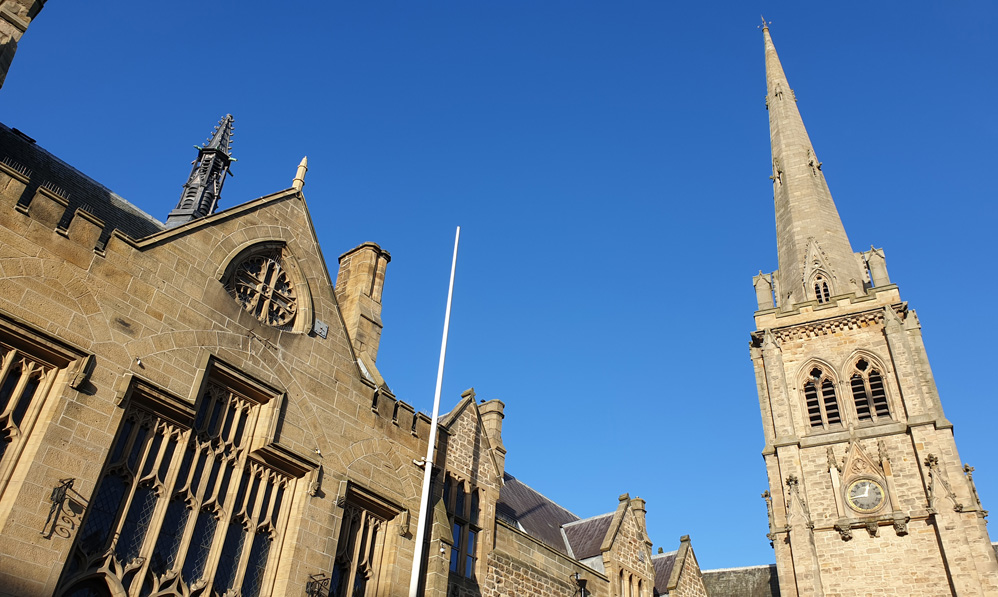Nestled right in the vibrant centre of Durham City, overlooking the Market Place, St Nicholas Church—affectionately known as St Nic’s—is one of the most accessible and welcoming churches in Durham. With its prominent spire, neo-Gothic architecture, and active role in the local community, St Nicholas Church is a spiritual and social landmark that blends centuries of history with modern outreach and inclusive worship.
A Church with Ancient Roots
The original Church of St Nicholas dates back to the 12th century, though it has undergone significant changes over the centuries. Originally built to serve the growing medieval market town outside the Cathedral precincts, it was a parish church for local tradespeople, merchants, and residents who lived and worked in the bustling market area.
Its dedication to St Nicholas, the patron saint of merchants and sailors, is particularly fitting given its proximity to the River Wear and the historical importance of Durham’s market economy. Over time, the church became a spiritual home not just for locals but also for pilgrims visiting the nearby Cathedral shrine of St Cuthbert.
Victorian Rebuilding and Architecture
The present-day building is the result of a complete Victorian rebuild in 1858 by renowned architect James Pritchett, who designed it in the Gothic Revival style. The reconstruction was considered necessary due to the poor condition of the medieval structure, but care was taken to preserve the original location and function of the church.
Pritchett’s version features a tall and elegant stone spire, prominent lancet windows, decorative tracery, and pointed arches, giving the building a strong vertical emphasis. It’s one of the most striking buildings in Durham Market Place and adds significantly to the historic cityscape.
Inside, the church is bright and spacious, with a simple yet reverent atmosphere. The layout allows for both traditional worship and modern gatherings, with flexible seating arrangements and facilities that support community use.
A Hub of Worship and Community Life
Unlike many historic churches that function mainly as heritage sites, St Nicholas Church remains an active parish church and a lively hub of Christian worship. It belongs to the Church of England, within the Evangelical tradition, and is known for its welcoming, family-oriented, and community-focused ethos.
Regular services include Sunday morning worship, evening prayer, midweek services, and special events around Easter and Christmas. Music, contemporary liturgy, and accessible preaching are hallmarks of worship at St Nic’s, attracting students, families, and visitors alike.
The church places great emphasis on youth work, community outreach, discipleship, and prayer. There are dedicated ministries for children, teens, students, and young adults, making it especially relevant in a university town.
Outreach and Social Engagement
St Nicholas Church takes seriously its mission to serve not just churchgoers, but the wider community. In recent years, it has launched and supported several outreach initiatives, such as:
- The Gateway Project, which provides food and support to vulnerable people and those in crisis.
- Student Welcome events, particularly during university Freshers’ Week, to help students integrate into the city and feel at home.
- Alpha courses, which offer a relaxed environment for those exploring the Christian faith.
- Events for local schools, including carol services and educational visits that help children engage with faith, history, and music.
The church also works with other local churches, Durham Cathedral, and city organisations to support joint events and city-wide celebrations.
A Landmark in the Market Place
Situated at the centre of Durham’s pedestrianised Market Place, St Nicholas Church serves as a visible and symbolic presence of faith at the heart of public life. Its doors are often open during the day, offering a space for quiet prayer, rest, or conversation amid the city’s busyness.
Its location also makes it an ideal venue for community events, concerts, lectures, and seasonal celebrations. The church’s spire is a familiar sight from across the city and even from the surrounding hills, acting as both a beacon and a meeting point.
During festivals such as Durham Lumiere, Heritage Open Days, and the Christmas Light Switch-On, St Nicholas Church plays a central role—hosting art installations, services, or simply providing a warm welcome to visitors.
Music and the Arts
Music is an important part of life at St Nic’s. The church regularly hosts musical performances ranging from worship bands and choral groups to visiting ensembles and soloists. It also supports the arts more broadly, sometimes collaborating with Durham University, local schools, or community organisations on cultural programming.
Art installations, exhibitions, and seasonal displays are part of the church’s effort to make the building visually engaging and spiritually nourishing.
Modern and Historic
Though rooted in ancient tradition, St Nicholas Church reflects modern Durham—a city that embraces students, tourists, families, and workers. It bridges the sacred and the everyday, remaining relevant to the contemporary spiritual landscape while maintaining deep links with the city’s medieval and ecclesiastical history.
Its commitment to hospitality, its central location, and its focus on community engagement make it one of Durham’s most approachable places of worship.
Visiting St Nicholas Church
If you’re visiting Durham, St Nicholas Church is well worth a stop. Whether you’re looking to attend a service, explore local history, enjoy music, or simply sit quietly in a beautiful space, the church offers an open door.
Admission is free, and the church is typically open most days of the week. Volunteers are often on hand to answer questions, and leaflets provide information about the building’s history and current ministry.
The church’s website and social media are kept up-to-date with information on services, events, and outreach activities, making it easy for both visitors and locals to get involved.
Conclusion
St Nicholas Church is more than just a historical landmark—it’s a living, breathing part of Durham’s identity. With its blend of architectural beauty, spiritual vibrancy, and social conscience, it continues to serve as a light in the city, just as it has done for over 800 years.

